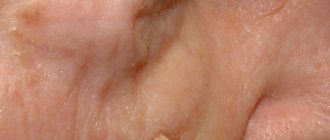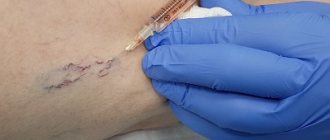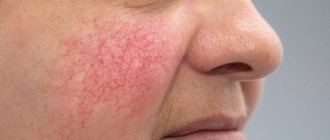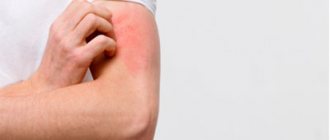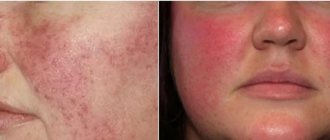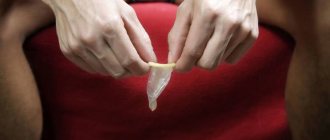Even the most minor skin defects can cause discomfort for a person. Among defects of this kind, it is worth highlighting spider veins (SV), which are called “telangiectasia”. The expansion of skin capillaries contributes to their appearance. Externally, this defect consists of cobwebs, dots or winding lines that are red-violet in color.
As a rule, telangiectasia appears more often in women. However, its development in men is also possible. The main areas that are most often affected by this defect are:
- chin;
- cheeks;
- wings of the nose;
- legs.
SZ are not the result of an inflammatory process in the body and do not cause pain to a person. If you press on the defect, it may become lighter or disappear altogether. However, after some time, the red-violet web will reappear on the skin under the influence of blood vessels filling.
SZ is not a health or life-threatening pathology. However, in some cases they represent symptoms of certain vascular diseases that require mandatory consultation with a specialist. If telangiectasia occurs, you can seek qualified advice from our medical doctors. Here, every patient is guaranteed to receive professional help.
Causes of spider veins
Spider veins, medically called telangiectasias, are dilated capillaries (small blood vessels) with a diameter of up to 1.5 mm, blue or red. They are localized on any part of the body, but are most often found on the legs and face. The cause of their occurrence is stagnant processes in the bloodstream due to hemodynamic disturbances.
The risk group for the development of this pathology includes people who are obese, are exposed to heavy physical activity, are on their feet for a long time due to professional activities and lead a passive lifestyle.
Symptoms
Dilated capillaries can be found throughout the body - on the face, arms, legs. According to external signs, vascular dilations are divided into:
- linear
- point
- arachnids
- tree-like
The linear appearance of the stars is usually located on the wings of the nose and cheeks. Pathology is a cosmetic disease called “culerosis”.
Point vascular branches develop with varicose veins of the extremities. The affected areas are sore and intensely discolored.
Arachnid and dendritic vascular changes include numerous enlarged capillaries. They have a red tint and diverge in different directions. They are localized in all parts of the human body.
It's all due to hormones
One of the main factors provoking the development of spider veins is a hormonal imbalance in the body.
Restructuring of the endocrine system occurs in the following conditions:
- pregnancy;
- menopause;
- uterine fibroids;
- ovarian cyst;
- abortion and others.
Pregnant women complain about the appearance of vascular “spiders” in the face, legs and abdomen precisely in the last stages of pregnancy. This is due to increased stress on weakened blood vessels. They stretch under the influence of pressure inside themselves and protrude above the surface of the skin.
Telangiectasia often affects the skin after taking birth control pills or installing a hormonal IUD. That is why the selection of contraceptives should be carried out by a gynecologist based on the results of the examination. If a woman notices scarlet stars on her chest, then this is a reason to contact a mammologist or oncologist. Breast cancer at an early stage can manifest itself with these symptoms.
What is a laser in the modern sense?
A laser is a device that creates a powerful stream of electromagnetic radiation with a certain wavelength. In other words, it is a beam of high intensity monochromatic light. The postulates that made it possible to create such a device were formulated by Albert Einstein at the beginning of the 20th century, and the first optical quantum generator (laser) producing waves in the optical range was created in 1960 by Theodore Maiman (USA).
Laser generator "CUTERA XEO"
Varicose veins and spiders
The formation of spider veins on the legs is often associated with the first signs of a disease such as varicose veins. Patients mistakenly believe that it covers only the large main vessels of the legs, and in medicine they believe that capillaries are also susceptible to the occurrence of the disease.
When the vessels of the lower extremities are affected, tree-like telangiectasias of red or blue color are found, which resemble a mesh. If measures are not taken in time, the disease begins to progress, and other symptoms appear: night cramps in the legs, leg fatigue, pain when walking. To avoid unpleasant consequences, you need to consult a phlebologist who diagnoses and treats diseases of the arteries and veins of the lower extremities.
How to get rid of spider veins
The most commonly used technique for eliminating them all over the world is sclerotherapy - that is, the injection of a special drug into a vein using a very thin needle, which leads to their disappearance. Sometimes this procedure can not only improve appearance, but also eliminate some symptoms of chronic venous diseases: itching, burning, heaviness in the legs, night cramps.
In addition to sclerotherapy, percutaneous laser and thermocoagulation are also used to treat spider veins, but the frequency of their use does not exceed 5% of cases. We especially want to emphasize that it is impossible to remove spider veins with any tablets, ointments or creams, so you should not trust this kind of advertising! Before removing spider veins, you will first undergo an ultrasound examination of large veins to exclude their pathology. If changes are detected in these vessels, it is advisable to treat them at the first stage in order to achieve the best result. However, this situation occurs rarely, because damage to large veins is usually visible to the naked eye. In the corresponding section you can also learn more about the treatment options for varicose veins. We hope you find our site informative.
Rice. 3 Result of sclerotherapy
Important! No cream, ointment or drug can remove spider veins.
In the corresponding section you can also learn more about the treatment options for varicose veins.
Sign up for a consultation with us to learn more about spider veins and their treatment methods that are suitable specifically for your case.
Spider veins in obesity
It is no secret that the body of obese people daily experiences a load tens of times higher than normal. Stretched and flabby vessels, which are not able to perform their job efficiently, are called upon to supply a rather large body with blood. This is why spider veins are common in people who are overweight. And the greater this excess, the greater the likelihood of this pathology occurring. Low physical activity in such a situation only contributes to the aggravation of the process: stagnation in the bloodstream begins to form, contributing to the development of thrombophlebitis.
The mechanism of laser action on blood vessels
The ultimate goal of laser treatment is to induce damage to the vessel wall by destroying hemoglobin while minimizing damage to adjacent structures. When selecting a laser, the first step is to determine the spectral absorption peaks of the target chromophore. In the case of vascular lesions, this is deoxyhemoglobin, oxyhemoglobin, and also water. Laser systems used to treat vascular lesions emit wavelengths near these peaks. Longer wavelengths are preferred for relatively deep vascular lesions such as leg veins, while shorter wavelengths are more suitable for superficial vascular lesions such as spider veins and telangiectasias on the face.
Laser platform "CUTERA XEO"
After choosing a suitable laser, it is important to correctly configure the radiation parameters. These include pulse duration, energy density, and light spot size. The pulse duration is determined by the thermal relaxation time (TRT) of the target. Essentially, it is defined as the time it takes for a heated fabric to lose about half of its heat. A laser pulse that is shorter than or equal to the TRT will result in damage limited to the target vessel. The energy density and size of the light spot will directly affect the depth of optical penetration (into tissue). That is, an increase in these parameters will be required if the target is located deep inside the dermis, with a larger diameter of the target vessel.
In the treatment of all vascular lesions, cooling the skin surface is important to minimize damage to the epidermis.
Other causes of spider veins
Pathological changes in the form of spider veins may be a harbinger of systemic connective tissue damage. Doctors call this disease scleroderma, and it is characterized by abnormal thickening of the skin, leading to poor circulation. The pressure created for the passage of blood through compressed capillaries stretches their walls, forming a kind of vascular “spiders”.
A similar process of formation of telangiectasia is characteristic of diseases associated with the liver and gall bladder. In case of cirrhosis or liver cancer, they appear on the skin of the anterior abdominal wall (“head of the jellyfish”) and indicate sclerosis of the liver structures.
Spider veins can also be caused by other factors:
- cardiovascular diseases;
- decreased vascular tone due to lack of vitamins C and P;
- constant exposure to heat on the body;
- blood clotting disorder;
- hereditary predisposition;
- exposure to UV and radiation on the body.
Significantly increased blood pressure, at which small vessels can simply burst from stress, can also contribute to the formation of single telangiectasias.
Diagnosis of the disease
“If you are experiencing similar symptoms, we advise you to make an appointment with your doctor.
You can also make an appointment by phone: +7 (499) 214-00-00 Doppler ultrasound is performed to assess the state of blood flow. Diagnostics allows you to obtain the necessary information about blood circulation in peripheral vessels, find out the speed of blood flow, and detect existing disorders.
Additional diagnostic measures include a functional examination of the genital organs, liver, and heart. After performing the necessary studies, the doctor assesses the nature of the pathology.
Prevention of spider veins
If telangiectasias appear on the body without a clinical reason, then recurrence of the cosmetic defect can be prevented by the usual intake of a vitamin complex. It should include substances that help restore tone and strengthen the vessel wall.
To prevent asterisks from arising as a result of any disease, you need to take preventive measures. First of all, give up bad habits, follow the principles of a healthy diet and lead an active lifestyle.
Find out the cost
History of the development of laser medicine
Vascular formations of various locations, being cosmetic defects, often cause psychological discomfort in both women and men. The first attempts to solve such problems using laser radiation were made in the late 60s and early 70s of the last century. An argon laser with continuous radiation was used. Despite its effectiveness, the abundance of undesirable reactions (scarring, permanent dispigmentation) significantly limited the use of this technique.
The formulation of the theory of selective photothermolysis by Harvard Medical School scientists Richard Anderson and John Parrish in 1983 changed the situation. This created a kind of revolution in laser medical technologies. The basis of this theory is the selective absorption of radiation with different wavelengths by different substances. That is, a light beam of a certain monochrome light will be absorbed by a chromatophore substance (the concentration of which in the target cell is much higher), impart energy to it and cause a corresponding effect, without affecting the surrounding tissues. Determining the appropriate wavelength, pulse duration and energy density allowed doctors to selectively target hemoglobin in blood vessels without damaging surrounding tissue. The result of this tactic was a sharp reduction in side effects, such as hypo- and hyperpigmentation, and an almost complete absence of scarring.
Reviews about removing spider veins on the legs
I would like to express my deep gratitude to the chief physician and founder of the Center for Modern Phlebology clinic, Artem Yuryevich Semenov!
To the high professionalism of the doctor, add his sensitivity, attentiveness and caring attitude towards the patient, as well as his sense of humor. I had sclerotherapy sessions at his clinic. The doctor removed my so-called spider veins, which so ruin the lives of women! It took me a long time to decide to come. But a friend who already...More details Elena Maksimova, Moscow
I, Tikhomirova Natalya Vasilyevna, express my heartfelt gratitude to the doctor phlebologist Artem Yuryevich Semenov for his skill, professionalism, golden hands, attentiveness and for the miracles that happened to my legs during such a short course of sclerotherapy. Sclerotherapy is an excellent method of treating spider veins that does not take much time, does not cause discomfort, and does not interfere with everyday life. Tikhomirova Natalya Vasilievna, December 23, 2020, Moscow More details
Tikhomirova Natalya Vasilievna, December 23, 2020, Moscow

